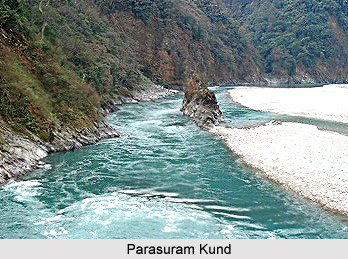 History of Lohit district suggests a series changes before the district actually obtained its actual name. The name of Lohit district is derived from Lohit River. Initially, before the year 1914, Lohit district was actually a part of Lakhimpur district. By the year 1914 the North East Frontier Tract was formed with three separate political charges and the portions covered by this district become a part of the central and Eastern Section. In the year 1919, the Central and Eastern Section was renamed as the Sadiya Frontier Tract. Some area from both the Sadly Frontier Tract and the Lakhimpur Frontier Tract were curved out and Tirap Frontier Tract was formed in 1943. Under the North East Frontier Tracts (Internal Administration) Regulation, 1948, the remaining portion on the Sadiya Frontier Tract was alienated into two separate managerial charges, namely the Abor Hills District and the Mishmi Hills District each with headquarters at Pasighat and Sadiya respectively. In 1951, the plains portion of the Mishmi Hills District was transferred to administrative jurisdiction of the state government of Assam. The headquarters of the Mishmi Hills District was transferred from Sadiya to Tezu in the year 1952.
History of Lohit district suggests a series changes before the district actually obtained its actual name. The name of Lohit district is derived from Lohit River. Initially, before the year 1914, Lohit district was actually a part of Lakhimpur district. By the year 1914 the North East Frontier Tract was formed with three separate political charges and the portions covered by this district become a part of the central and Eastern Section. In the year 1919, the Central and Eastern Section was renamed as the Sadiya Frontier Tract. Some area from both the Sadly Frontier Tract and the Lakhimpur Frontier Tract were curved out and Tirap Frontier Tract was formed in 1943. Under the North East Frontier Tracts (Internal Administration) Regulation, 1948, the remaining portion on the Sadiya Frontier Tract was alienated into two separate managerial charges, namely the Abor Hills District and the Mishmi Hills District each with headquarters at Pasighat and Sadiya respectively. In 1951, the plains portion of the Mishmi Hills District was transferred to administrative jurisdiction of the state government of Assam. The headquarters of the Mishmi Hills District was transferred from Sadiya to Tezu in the year 1952.
According to the North East Frontier Areas Regulation 1954, the North-East Frontier Tract was known as North-East Frontier Agency and the Mishmi Hills District came to be known as the Lohit Frontier Division. In 1956, the Dibang Valley was constituted as a separate administrative unit and it was placed under the charge of Additional Political Officer with his headquarters at Roing. Again under the North-East Frontier Agency (Administration) Regulation, 1956 the Lohit Frontier Division came to be known by its present name the Lohit District. In June, 1980 under the Arunachal Pradesh (Re-organisation of district), Act 1980 the Lohit District was divided into two independent district namely Lohit District and Dibang Valley District. Tezu is the district headquarters of the Lohit District.
However, the ancient history of the Lohit District is not concreted due to scarcity of proper historical literary or material evidence yet the lower belt of the district is the base for evidence for existence of the ruins of ancient settlement, buildings, shrines and temples. Interestingly, the Parasuram Kund, Tamreswari temple, Lord Shiva linga site and the city of king Bhismak situated in this region are mentioned in the Puranic Indian Literature and Tantric literatures.



















